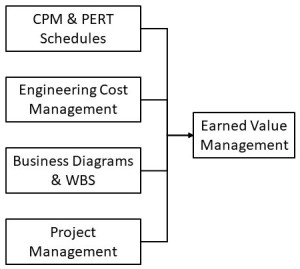Over the last couple of months there has been a discussion running in the Project Management World Journal around the purpose of EVM. The general consensus seems to be EVM is a performance management system, focused on measuring the performance of the managers assigned to manage the work packages, control accounts and overall project. Identifying emerging issues early, at the work package level allows management intervention to improve the situation.
EVM was developed in the 1960s, based on PERT COST, which in turn was developed from the PERT TIME scheduling system[1]. EVM also drew on the well-established practice of cost engineering[2], but these two disciplines are designed for very different purposes. Cost engineering is focused on project cost estimating and control, EVM is focused on performance management. Appreciating the difference between financial management, cost accounting, cost engineering, and earned value management is important for their successful implementation. These terms are not, and never have been, synonymous.
Our latest published article The Purpose of Earned Value Management summarizes the discussion and identifies the role of EVM in a comprehensive project controls framework. Download from https://mosaicprojects.com.au/PMKI-SCH-040.php#Overview
For more on the implementation of EVM and free EVM resources see: https://mosaicprojects.com.au/PMKI-SCH-040.php
[1] For more on The Origins and History of Earned Value Management see: https://mosaicprojects.com.au/PDF_Papers/P207_EVM_History.pdf
[2] For more on The Origins and History of Cost Engineering see: https://mosaicprojects.com.au/PDF_Papers/P207_Cost_History.pdf







